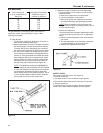
VI
CTORY
II V
HS Models
26
A
PPENDIX A
Vent System Location and Condensation
Drain Requirements
1
. The venting system shall terminate at least 3 feet
above any forced air inlet located within 10 feet.
2
. The venting system shall terminate at least 4 feet
below, 4 feet horizontally from, or 1 foot above any
door, window or gravity air inlet into any building.
The bottom of the vent terminal shall be at least 12
inches above grade or the nor
mal snow level,
whichever is greater.
3.
Through the wall vents for Category II and IV appli-
ances shall not terminate over public walkways or
over areas where condensate or vapor could create
a nuisance or hazard or could be detrimental to the
operation of regulators, relief valves or other equip-
ment. Minimum clearance of 4' horizontally from,
and in no case above or below, unless a 4' horizon-
tal distance is maintained, from electric meters, gas
meters, regulators and relief equipment. Where
local experience indicates that condensate may be
a problem with Category
I and III appliances, this
provision shall also apply.
4. Provision shall be made to collect and dispose of
condensate from v
enting systems serving Category
I, II, III and IV appliances.
Caution
Flue gases exiting from the vent terminal will con-
dense. Building materials in the area of the vent termi-
nal should be protected from discoloration and degra-
dation.
A
PPENDIX B
Removal of Existing Boiler From
Common Vent System
a
. Seal any unused openings in the common venting
system.
b
. Visually inspect the venting system for proper size
and horizontal pitch and determine there is no
blockage or restriction, leakage, corrosion and
other deficiencies which could cause an unsafe
condition.
c. Insofar as is practical, close all building doors and
windo
ws and all doors between the space in which
the appliances remaining connected to the com-
mon venting system are located and other spaces
of the building. Turn on clothes dryer and any appli-
ance not connected to the common venting sys-
tem. Turn on any exhaust fans, such as range
hoods and bathroom exhausts, so they will operate
at maximium speed. DO NOT operate a summer
exhaust fan. Close fireplace dampers.
d. Place in operation the appliance being inspected.
Follow the lighting instructions. Adjust thermostat
so appliance will operate continuously.
e. Test for spillage at the draft hood relief opening
after 5 minutes of main burner operation. Use the
flame of a match or candle, or smoke from a ciga-
rette, cigar or pipe.
f. After it has been determined that each appliance
remaining connected to the common venting sys-
tem properly vents when tested as outlined above,
return doors, windows, exhaust fans, fireplace
dampers and any other gas burning appliance to
their previous conditions of use
.
g. Any improper oper
ation of the common venting
system should be corrected so the installation con-
forms with the National Fuel Gas Code, ANSI
Z223.1-latest edition. When resizing any portion of
the common venting system, the common venting
system should be resized to approach the mini-
mum size as determined using the appropriate
tables in Appendix G in the National Fuel Gas
Code, ANSI Z223.1-latest edition.


















